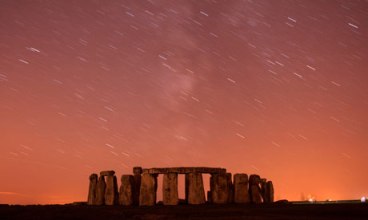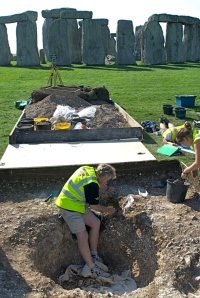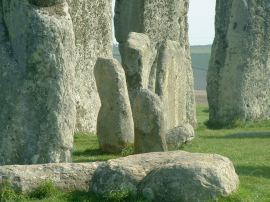2014 will be a vintage year to visit Stonehenge and Wiltshire
The removal of a nearby road and the construction of a new, off-site, visitor center will return England’s prehistoric stone circle, Stonehenge, to a more tranquil, natural setting. Until now, facilities to welcome visitors to the World Heritage Site have been limited and outdated. But the project led by English Heritage to transform Stonehenge not only provides world-class facilities, but also returns a sense of context and dignity to this ancient marvel of human endeavour.
After removal of the road and high ugly fencing right next to the Stone Circle the old parking area and visitor buildings will be cleared and is currently being grassed. Eventually, the road, car park and visitor buildings will be gone – leaving Stonehenge surrounded by grass and reunited with its ancient approach, the Avenue. Visitors will be able to enjoy the special atmosphere of the Stone Circle with fewer distractions from modern–day sights and sounds. English Heritage will open the new visitor centre in the winter of 2013.The past year has seen epic improvements. Over £40 million pound has been invested to offer the best experience since Neolithic times.
Stonehenge Tours
 By far the easiest and most convenient way to experience Stonehenge is by joining a guided tour from London, Salisbury or Bath.
By far the easiest and most convenient way to experience Stonehenge is by joining a guided tour from London, Salisbury or Bath.
Stonehenge is in a remote area of the West Country and can be difficult and costly via public transport. There are many operators (some better than others) offering half and full day tours that include Stonehenge and other popular attractions in the West county. Typical itineraries from London include;
- Stonehenge, Bath, and Lacock Village in the Cotswolds
Stonehenge, Salisbury Cathedral and Avebury Stone Circle
Stonehenge, Oxford and Windsor Castle
Stonehenge Special Access Tours
Most tours enter Stonehenge during public opening hours of Stonehenge. 2014 will see the introduction of a ‘monorail’ travelling some 2km from to the monument which will be a greatly improved experience to previous years. If you are able to plan ahead we strongly recommend booking a ‘private access inner circle tour’ which offer guided trips outside of public opening hours but there are very limited sessions where you can actually walk among the stones and demand is great. These sessions are very early morning or evening on a tour its either a very early start from London or a late return in the evening. These viewings are called ‘special access’ or ‘inner circle’ tours. Some operators even go to the length of gaining access during the actual sunrise or sunset and we highly recommend this if you are able to book in advance.
2km from to the monument which will be a greatly improved experience to previous years. If you are able to plan ahead we strongly recommend booking a ‘private access inner circle tour’ which offer guided trips outside of public opening hours but there are very limited sessions where you can actually walk among the stones and demand is great. These sessions are very early morning or evening on a tour its either a very early start from London or a late return in the evening. These viewings are called ‘special access’ or ‘inner circle’ tours. Some operators even go to the length of gaining access during the actual sunrise or sunset and we highly recommend this if you are able to book in advance.
Stonehenge’s orientation on the rising and setting sun has always been one of its remarkable features. Whether this was simply because the builders came from a sun-worshipping culture, or because – as some scholars believe – the circle and its banks were part of a huge astronomical calendar, remains a mystery.
By far the best way to experience Stonehenge is on a sunrise / sunset guided tour.
Stonehenge Guided Tours from London
The highly recommended ‘Stonehenge Guided Tour’ Company, known as the ‘Stonehenge Experts’ have been offering daily scheduled coach tours and exclusive ‘special access’ tours since the early 1990’s and have the best reputation by far – visit their website here: Stonehenge Guided Tours
Premium tours, Golden Tours, Welcome2Britain and Evan Evans also offer coach or mini bus tours from London on limited dates and can be booked through the established discount sightseeing tour website BestValueTours
Local Stonehenge tour Operators.
There are also local operators offering tours from Salisbury, Bath and the port of Southampton. Staying close to Stonehenge gives the opportunity to absorb local culture and its rich history and get a taste of the real England that many tourists miss whilst staying in the tourist capital of London.
Stonehenge Guided Tours from Bath
Mad Max Tours and Lion Tours are on hand to offer day trips from Bath to Stonehenge, Avebury Stone Circle, Lacock (as seen in the Harry Potter films) and the Wiltshire Cotswolds. Wessex Guided Tours offer private guided tours from Bath for families and small groups wishing to experience Stonehenge and explore ancient Wiltshire
Stonehenge Guided Tours from Salisbury
For expert knowledge on the history of Wiltshire, local guides can help you discover the myths, the history and the legends behind this county:
The Stonehenge Tour Bus is an ideal way to learn about the history of Stonehenge if you are travelling by public transport. The hop-on hop-off service stops at Stonehenge and Old Sarum and gives a recorded commentary on the history of Salisbury.
The Stonehenge Travel Company based in Salisbury offer scheduled small group guided tours including the popular Stonehenge sunset special access tours and can often arrange additional dates for private groups. Their exclusive tours; half and full day options are also available. There popular tours also visit the other Neolithic sites like Woodhenge, Durrington Walls, Avebury Stone Circle, Silbury Hill, West Kennet Long Barrow, Chalk Hill Figures and also get you off the tourist trail seeing some of the delightful English countryside in the area.
There’s also Salisbury, Stonehenge and Sarum tours with their minibus and tour in several languages.
Visit Wiltshire
The official ‘Visit Wiltshire’ tourism association also have a list of approved tour local operators and transport providers: Click here
Wiltshire is a perfect all-year destination for groups with plenty to see, do and experience. Extend your day visit to an overnight stay and see more of what Wiltshire has to offer. With a history spanning over 6,000 years, we have Stonehenge and Avebury World Heritage Site, Britain’s tallest Cathedral spire in Salisbury and the Magna Cartta, magnificent stately homes and gardens and some great shopping experiences. Download the Visit Wiltshire and Visit Salisbury Apps and have up to date information at your fingertips!
Whether you are travelling from overseas or live in the UK, make 2014 the year to visit Stonehenge and explore historic Wiltshire
The Stonehenge News Blog




























